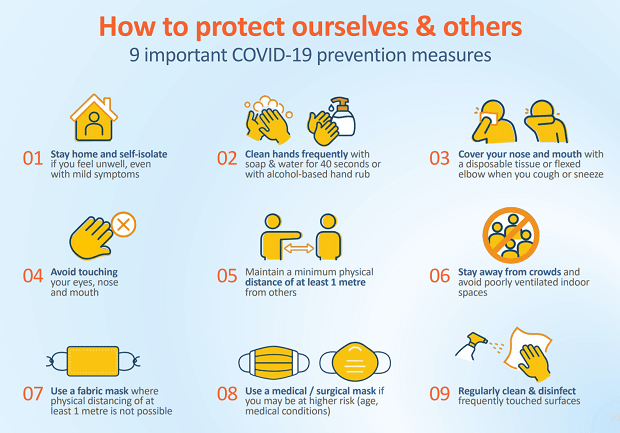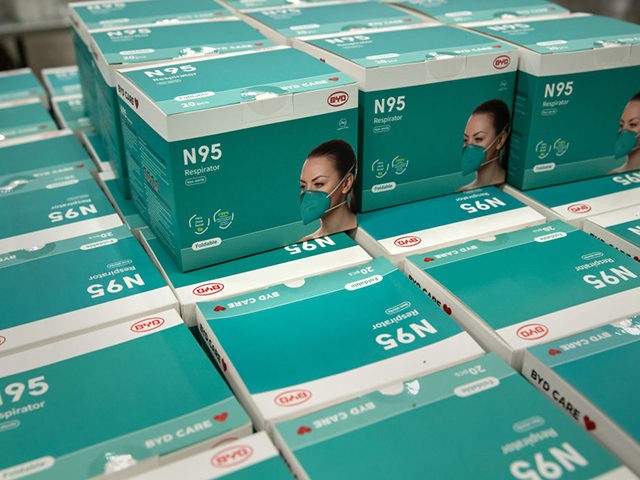The most recent update to the World Health Organization’s (W.H.O.) guidelines for dealing with the Wuhan coronavirus, posted on November 1, includes a recommendation to use fabric face masks only when “physical distancing of at least 1 meter is not possible,” and for only high-risk groups to use medical-grade masks.
W.H.O. proposed “9 important Covid-10 [Chinese coronavirus] prevention measures.” The first advised people who feel unwell or display “mild symptoms” of the coronavirus to “stay home and self-isolate,” an approach consistent with traditional epidemic control procedures, but different from the massive lockdowns of healthy people imposed throughout most of the world during the Chinese coronavirus crisis.
W.H.O. recommended maintaining a physical distance of at least one meter (a little over three feet) from other people, staying away from crowds, and avoiding “poorly ventilated indoor spaces.”
If maintaining a meter of social distancing is not possible, the use of a fabric mask was advised. Medical or surgical masks were recommended for those in high-risk categories, such as the elderly and those with pre-existing medical conditions.
W.H.O.’s supplementary material stated that medical masks should be worn by “health workers, people who have Covid-19 [Chinese coronavirus] symptoms, and those who take care of someone suspected or confirmed with Covid-19.”
“In areas where Covid-19 is widespread and physical distancing of at least one meter cannot be achieved, medical masks should be worn by people who are aged 60 years old or over, and those who have underlying health conditions,” W.H.O. recommended.
“Fabric masks, also known as non-medical masks, should be worn by people who have no Covid-19 symptoms where Covid-19 is widespread and physical distancing of at least one meter can’t be achieved,” the specific guidelines continued.
“This may include people who are in close contact with others, such as social workers, cashiers, and servers. Fabric masks should also be considered in busy public settings such as public transport like buses, share taxis, and trains, workplaces, grocery stores, and other crowded environments,” the W.H.O. update clarified.
Democrat presidential candidate Joe Biden assigned masks far greater value throughout his 2020 campaign. In his second debate with President Donald Trump, Biden claimed wearing more masks would have saved 100,000 people who were killed by the Wuhan virus.
“If we just wore these masks — the President’s own advisors told them — we could save 100,000 lives. And we’re in a circumstance where the President, thus far, still has no plan. No comprehensive plan. What I would do is make sure we have everyone encouraged to wear a mask, all the time,” Biden said.
Biden was evidently referring to comments about the importance of mask usage made by CDC Director Robert Redfield, who Biden quoted by name when making a similar claim in September about saving 100,000 lives with masks. Redfield did not actually specify an estimated number of lives he thought might be saved, although he did praise masks as “the most important, powerful public health tool we have.”
Pressed on the claim, the Biden campaign pointed to a model from the University of Washington’s Institute for Health Metrics and Evaluation that anticipated 224,000 more deaths from the coronavirus by January, or roughly 100,000 less with near-universal mask usage.
Biden called for a “national mask mandate” during his campaign, although he and other proponents of the idea admitted that the White House lacks the authority to issue such an order.
One of the last ads run by the Biden campaign, during the final week of the campaign, featured Biden stating, “It’s a simple measure, everyone needs to wear a mask in public” as the message “NATIONWIDE MASK MANDATES” appeared on the screen. CNN fact-checked the ad and found it misleading, noting that Biden would have no authority to impose a mandate and pointed out that he routinely fell back to saying he would ask governors and mayors to require masks when his mandate campaign promise came under fire.
“First, I’ll go to every governor and urge them to mandate mask-wearing in their states. And if they refuse, I’ll go to the mayors and county executives and get local masking requirements in place nationwide. As president, I’ll mandate mask-wearing in all federal buildings and all interstate transportation because masks save lives. Period,” Biden said on one such occasion in October.
Many of the states and municipalities that have imposed mask mandates — such as Wisconsin, whose mandate weathered a court challenge in October — have also experienced “surges” of coronavirus cases. Mask advocates insist the surges do not prove that masks are ineffective, in some cases blaming poor public compliance with the mandates for the spike in coronavirus transmission.
Other countries where mask mandates are legal have also experienced coronavirus surges, including authoritarian Russia, which ordered nationwide use of masks in October as infections spiked, but nevertheless reported a record number of new cases on Wednesday.

COMMENTS
Please let us know if you're having issues with commenting.